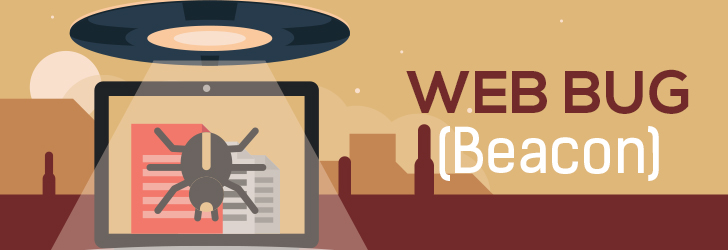Users Online
· Members Online: 0
· Total Members: 188
· Newest Member: meenachowdary055
Forum Threads
Latest Articles
Articles Hierarchy
What is a Web Bug (Beacon)?

A web bug is also referred to as web beacon, pixel tag, clear GIF, invisible GIF. It is one of the techniques used in emails or web pages to check what the user has accessed. These are in most cases invisible and are used for web analytics. In most cases, web bug arrives in the form of an image and can be detected by the user only if the source code is checked. A web bug is small graphic and hence can work easily with low bandwidth or weak network connection.
Usage of web bug is still debatable. Some consider the usage of web bug as positive with its ability to provide high-level analytics for business. On the other hand, few others consider this as intrusive and concerning.
In many cases, web beacons are also referred to as a transparent beacon that constitutes of an image which is a pixel having a dimension of 1x1. A web bug has several positive aspects and can be used to track the following statistics:
- The time the web bug was accessed or viewed
- The type of user browser that has fetched the web bug
- IP address of the system that accessed the web bug
- How long the web bug was active or used
- Help provide data about user preferences
- Advertisers can build up browsing profiles for customers to display the most appropriate Ads
Spammers can use web bug to validate email addresses. Using a web bug, the sender can validate if the user has accessed the email and thereby the sender can validate the authenticity of the email address.
How does Web Beacon work?
Whenever your browser tries to render a web page, it also renders the images within the page. The browser makes a request to the server to download the image. With this request, the web server will log certain details such as IP address, timestamp, and few other details. By useing web bug, the web server can track how many times you have accessed the page, your location, and a few additional user specifics. The request can also make a reference to an existing cookie which was earlier set by the server on the user's computer. This helps the webmaster to understand user preferences and build a profile based on user preferences. Not only do web bugs work over websites, but it can also be used over emails. It's a common practice to track and monitor emails and their click rates. MailChimp uses Open Tracking, a method used to insert images right inside the emails. Whenever the email server tries to download the image in the mail, an alert is sent to the web server. This is an important part of analytics for email marketing since they know if their email was opened or clicked.
Apart from this, web bugs can also be part of embedded links, usually in the form of a reference ID within the URL. On clicking of the embedded link, MailChimp can identify if the email was opened and when was it opened. Back in 2007, Facebook web bugs also commonly referred to as "Facebook Beacons" existed. Facebook beacon collected profile data from other Beacon partners about what users accessed and several other information. However, Facebook would also display these details on the user's profile without taking any prior consent. Another issue was, Facebook did not provide any privacy and security feature to turn off this feature. Owing to privacy concerns, Facebook finally had to suspend Facebook Beacons.
Difference between cookie and web bug: Cookies and web bugs are used for a similar purpose, which is to track user information. The purpose is to provide a better user experience. However, they are different in the way how they work. In many cases, the web bug is used in conjunction with cookies. A cookie can be a session cookie or a persistent cookie. Cookies enable faster interactions and are targeted to improve returning customer's user experience. You can accept or decline cookies. Most browsers allow you to set the cookie preference, which in most cases is by default turned on.
Web bugs, on the other hand, are part of images and aren't in any way visible to the user unless the user checks the source code. Unlike cookies, web bugs do not provide any options to accept or decline. However, from the browser's privacy section you can block cookies. This will also block web bugs. This feature is browser specific and will have to be done on individual browsers that you use. Once you disable cookies, few of the user interface or websites might not work as expected based on the website configurations.
BENEFITS OF USING WEB BEACON
Web Beacons do have some advantages and hence is one of the key reasons why many websites and email marketing campaigns focus on this.
- It allows you to advertise effectively based on interest.
- It is extremely cheap and is easy to implement.
- It enhances user experience through a selected personalization
- It provides useful data insights. Are data gold mines.
- It increases user engagement and retention of customers.
DISADVANTAGES OF USING WEB BEACON:
There are no specific disadvantages for web beacon. However, this may have few concerns as listed below:
- This requires coding expertise.
- It is technology dependent and implementation can vary based on technology.
- It should be implemented carefully to avoid any privacy-related issues.
CONCLUSION
Web Beacon is a powerful tool and can provide great data insights. Implementation of this in the right way can provide valuable data insights. This is an affordable option and does not require any expensive analytics tools.

